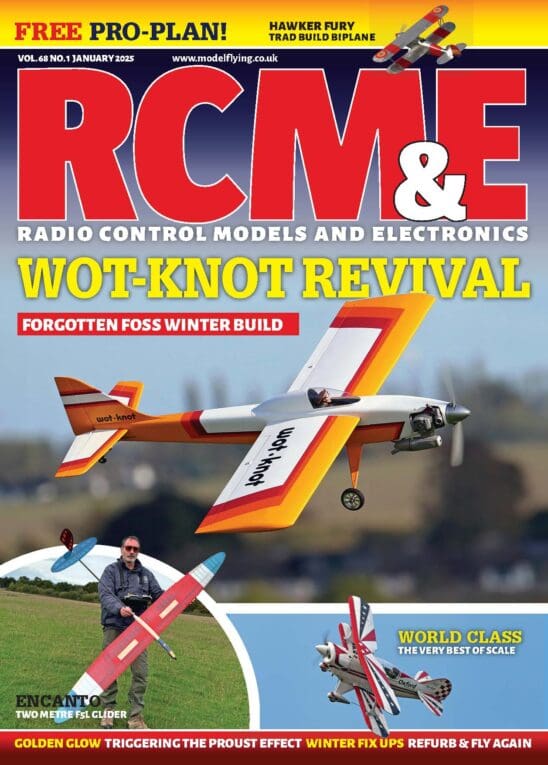Perhaps not the prettiest model you’ll find but she grows on you, note the wing lights added are not a part of the standard kit
The GWS Slow Stick is the best selling model you’ve probably never heard of. It’s been around for a while now, perhaps 7-8 years yet it doesn’t seem to have caught the attention here in the UK that it’s done overseas and the U.S. in particular. Over there the model has sold by the thousands yet few flyers or beginners here ever mention the Slow Stick.
GWS have revised the kit parts and the instructions a few times over the years but they continue to supply the model with a brushed speed 300 sized geared electric motor while a geared speed 400 unit upgrade is also available. The model is designed for a simple three-channel set-up using rudder, elevator and throttle for control.
Enjoy more RCM&E Magazine reading every month.
Click here to subscribe & save.
The Stick is a beginners model yet the versatile design has made her a favourite for night flyers, aerial photography enthusiasts and anyone who wants a stable, easy to fly model that’s cheap, easy to build and easy to repair – oh, and slow too.
The word ‘stick’ is appropriate, the model adopts a simple structure – a square metal tube fuselage with depron moulded foam wings and tail feathers. The wings are moulded to an aerofoil profile and the wide cord and generous span make for a huge lifting device that, with the right power-train, can haul a payload aloft for extended periods.

BUILD
The standard kit contents are comprehensive and include a motor and prop, wheels and a fine little selection of hardware along with GWS’ trademark generic plastic spruces with all manner of fittings.
Building the Stick is a simple enough task for experienced flyers and the difficulty level for beginners seems just right and pitched so it feels as if a degree of real ‘building’ is being undertaken. The fuselage boom accepts shaped slide-down formers/supports that serve a variety of tasks from supporting the wings to providing a mount for the radio gear, it’s all so simple that it’s actually a bit clever. The tail feathers stick and screw to the boom at the rear while a plastic joiner and metal and carbon braces support and hold the wing together which is then attached to the fuselage with bands. A couple of hours work should see things through to completion.
RADIO FIT
Cheap micro servos are what the SS requires along with a small receiver (a cheapie unit retrieved from a deceased park foamy in my case) and an Electronic Speed Controller (ESC). A 20-amp ESC is fine for the standard speed 300 motor while a 25amp ESC will do nicely for the 400 motor. My model here employed the GWS geared brushed speed 400 motor upgrade but a plethora of brushless motors can be fitted including GWS units. Beginners should be perfectly at home with the motor supplied in the kit but those using the model to carry lights or cameras would be best upgrading to (preferably) a brushless powerplant which will be more powerful and longer lasting with a small 3S 11.1v Li-Po battery.
 The perfect park fly hack, why not fit some lights and fly at night?
The perfect park fly hack, why not fit some lights and fly at night?
In this respect the model can fly on NiCads, NiMHs or Li-Pos although the majority of flyers will probably use 2 or 3S Li-Po packs. I’ve flown my model with a 3S 1100 and 1300mAh packs that provide a comfortable 10-minutes of flight. An 11.1v Li-Po battery driving a 6 or 7-volt brushed motor has the potential to push too many volts across and reduce the motors life span so while I’ve used this combination in my model with careful throttle control, the fact does re-inforce the suggestion for the use of a brushless motor.
FLYING
Take-offs are easy, the model will gather pace on the ground and then gently lift-off with barely any stick input required. The first thing that may suprise is just how slow the Stick flies – no really, the name is very apt. This model will happily get down to a walking pace so giving beginners the time to think and react – no bad thing. There are many models that are supposed to fly themselves but the Slow Stick really does that and will potter along happily with just a little bit of guidance from the user.
That’s great up to a point but the downside is that the model needs a flat calm day to perform. A very slight breeze is ok but beyond that she’s simply too light and the wing too big to cope, she’ll quickly become unpleasant or uncontrollable to fly.
She’ll stall if pushed but only if bags of elevator is fed in while the model is virtually stationary. Landings are a doddle, just cut the throttle and the SS will settle down while the big wheels and springy undercarriage soak things up with ease, they can cope with long’ish grass too.
 The Slow Stick is one of the best beginners models you can buy – the only downside being the near flat-calm weather required for flying
The Slow Stick is one of the best beginners models you can buy – the only downside being the near flat-calm weather required for flying
SO?
I’m now flying my third Slow Stick so I guess I must like it! I think it’s a great model for beginners and a simple, undemanding and relaxing model for anyone else. The Stick can really come into it’s own when you add a camera or lights too. The cost of getting the model into the air is very attractive, for instance –
…..assuming you already have a transmitter and battery charger of course.
DATAFILE




